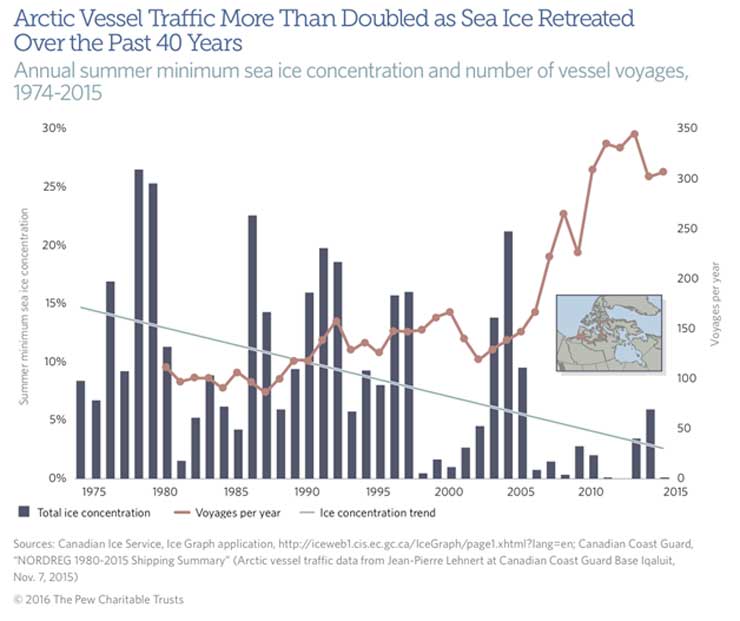The Arctic Ocean is defined by the International Hydrographic Organization (IHO), to consist of the circular portion of waters around the geographical North Pole. It does not encompass the surrounding seas, of the Barents, the Kara, and the Beaufort seas. The term ‘Arctic Ocean’ is used to describe all the waters of the North Polar Region that are above the North Polar Circle. States which have direct access to the Arctic waters are Iceland, Denmark (through Greenland), and Norway. During the Cold War, the Arctic involved hardcore security dimension involving nuclear and conventional competition. In the more contemporary times; economics, energy, and environmental aspects of security, have added to the already present conflict over sovereignty rights.
The Cold War era, involved the Arctic region to be perceived from the East–West hostility. In the 1950s, Arctic was the direct route from one superpower’s territory to the other. Since the introduction of nuclear submarines, it became a sanctuary and an outpost for the SSBNs. After the cessation of bipolar hostilities, the tensions gradually diminished and the risk of an all-out nuclear war with Russia was deemed rather less conceivable. Nevertheless, international developments indicating for a waning US power and emergence of a multi-polar order; has brought the states to once again strongly rely on submarine based nuclear deterrence. Added to that, the enlargement of NATO, has restricted the global maritime domain of the Russian Navy. Therefore, the northern waters provide the Russian Navy an access, which is likely to increase with anticipated melting of the polar ice caps. US similarly considers the region as strategically valuable in the context of their missile defense programme. The Thule radar located in Greenland have been upgraded to contribute to the early warning missile defence network.


NATO post-Cold War involvement and activities in the Arctic region decreased, as Russia was not perceived to be as great a direct threat as before. The discovery that the Arctic seabed conceals about 25 percent of the world’s remaining petroleum resources has transformed the region into a “top-of-the-agenda” strategic area. The melting of the polar ice cap will make the Northern Sea Route, along Russia’s northern coast and the Northwest Passage that is across Canada’s northern islands; valuable for trade between the Atlantic and the Pacific in the coming decades, engendering a significant reduction of the length of the route compared to the Suez–Malacca or the Panama routes. Moreover, the freeing of large portions of sea will allow exploitation of resources, including petroleum and fish, far away into the Arctic Ocean. Thus, the melting of the polar ice cap will open up new transportation routes as well as create new opportunities to exploit natural resources; this may in turn engender a militarisation of the Arctic.
In the Arctic region, the end of the Cold War opened the door to new processes of international, regional, or trans-regional cooperation. Thus, numerous initiatives fostering security and non-security cooperation have developed in the region: the Arctic Environmental protection Strategy (1991), the Barents Euro-Arctic Council (1993), the Arctic Council (1996), the CBSS (1992), the EU Northern Dimension (1997), and the Arctic Military Environmental Cooperation (1996). As these forums were created in the aftermath of the fall of the Soviet Union their aim was to provide forums outside the security arena, in order to foster cooperation in non-military fields. With ‘business as usual’ the EU’s energy import dependence will jump from 50 percent of total EU energy consumption today to 65 percent in 2030. Reliance on imports of gas is expected to increase from 57 percent to 84 percent by 2030, and of oil from 82 percent to 93 percent. Securing energy has not only an economic and an environmental dimension, but also a strong political, diplomatic, and security dimension. Competition for petroleum will increase, and the majority of the reserves are located in unstable countries and regions. It means that securing energy could require proactive policies, or even the use of force. Thus the Arctic commands a significant stature in the policy consideration.
Concluding, it can be said that Artic region predominates the hard security concerns. Although present situation cannot be compared with the Cold War escalations, the principles of realism based on an action and reaction strategy remain the cornerstone behind the relationship between US/NATO- Russia relationship in the Artic. The Russian Navy’s large exercises in the Barents Sea are documented to usually be followed by an increase in NATO presence and surveillance activities in the region. Moreover, the problems of sovereignty also illustrate the basic character of the frontiers in the Arctic region. China is the latest entrant in the power politics in the Artic. According to White Paper document it considers the Northern Passage as an “international strait”. The People’s Republic has plans to initiate what is called a “Polar Silk Road” to become an integral part of the Belt and Road Initiative to make productive use of shipping routes. In an address, former Norwegian defence minister Strom Erichsen had stated:
“Here in the High North global warming may open up potential natural resources that until now have been inaccessible. New sea lanes will shorten long distance routes considerably. Exciting opportunities will present themselves. Yet, competition and potential conflicts may be lurking in a future that suddenly is not so distant any longer”

No comments:
Post a Comment